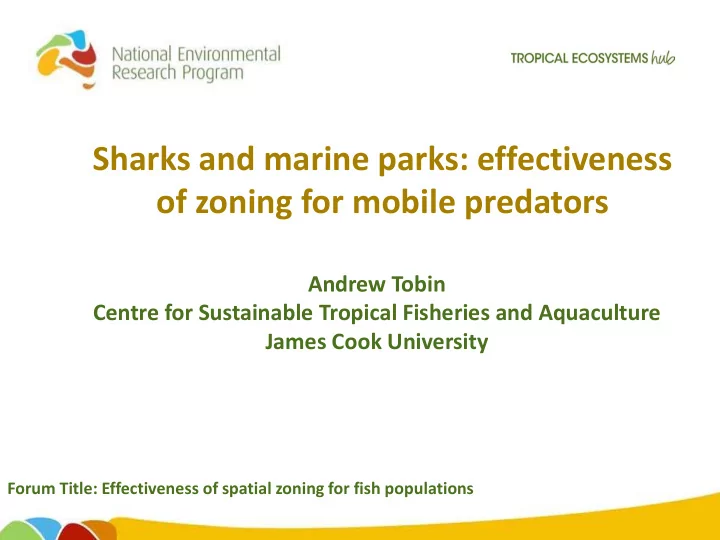

Sharks and marine parks: effectiveness of zoning for mobile predators Andrew Tobin Centre for Sustainable Tropical Fisheries and Aquaculture James Cook University Forum Title: Effectiveness of spatial zoning for fish populations
RELEVANCE OF WORK • Predatory fish are often some of the most exploited resources within marine communities • Because little is known about the presence and movement patterns of reef predators it is unclear how effective marine protected areas are for these species • A clear understanding of presence, movement and efficacy of marine park zoning is required to ensure the sustainability of exploited marine predators
RESULTS • Transmitters have been deployed in several reef predators species. This talk focuses on two examples: grey reef and bull sharks • Deployed transmitters: • Bluespot coral trout – 10 • Common coral trout – 60 • Red throat emperor – 19 • Giant trevally – 14 • Grey reef shark – 26 • Blacktip reef shark – 2 • Whitetip reef shark – 1 • Bull shark – 18 • Australian blacktip shark – 2 • Pigeye shark – 4 • Sliteye shark – 5 • Silvertip shark– 7 • Great hammerhead shark– 1
Tagging location of grey reef and bull sharks
Residency patterns of grey reef and bull sharks by reef
Residency patterns of grey reef and bull sharks by zone
Detection patterns of grey reef sharks and depth usage
Movement trajectories of bull sharks 215 cm male 208 cm female 195 cm female 235 cm female
RESULTS • Observed movements span marine park zones, inshore and reef habitats and may include cross-jurisdictional movements (see poster) • Broad-scale movement of sharks do occur, including small reef species (e.g. blacktip reef, grey reef) • Movement patterns are variable and difficult to predict • Broad movement patterns leave sharks exposed to a number of fishing fleets as they transit through areas • “Non-reef” sharks are moving between and spending considerable amounts of time in reef habitats, their influence in these systems is unknown
APPLICATION OF WORK • Given the variation in movement patterns among reef predators it is evident a single management strategy will not be equally effective for all species • Shark species are exposed to a range of fishing activities based on their movement through differing marine park zones and habitat regions • Future management needs to consider the broader movements of these species and possibility of cross-jurisdictional management issues • Marine park zoning alone will not provide adequate protection to exploited shark stocks, additional management measures and cooperation among agencies is likely required to ensure the stability of populations
FUTURE DIRECTIONS • Continue to deploy transmitters in additional reef predators • Continue to collect long-term movement data to define longer term patterns or trends in presence and movement • Advance analytical approaches to defining predator movement patterns • Examine broader movement patterns of species of conservation concern via satellite telemetry of hammerhead sharks
THANK YOU
Recommend
More recommend